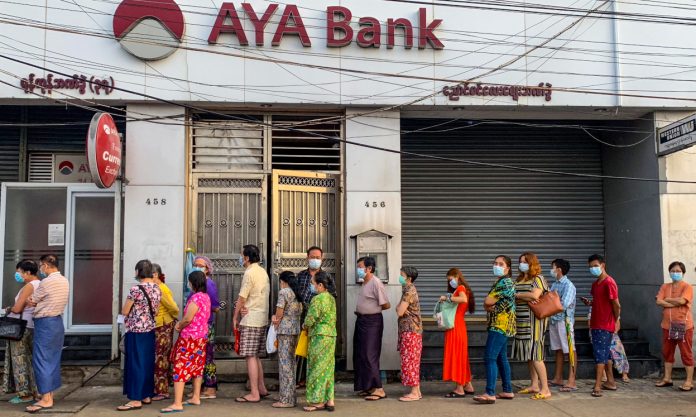After seizing power on 1 February 2021, the State Administration Council (SAC) military junta sought to stabilise the economy and ensure business recovery from the Covid-19 pandemic. More than ten months after the coup, the SAC’s promise is nowhere near being fulfilled. Instead, Myanmar’s economy faces a bumpy road ahead in the near term, with longer-term implications for the country’s sustainable development. Rather than treating symptoms via humanitarian assistance, the international community’s support for Myanmar’s substantive political transformation is essential for stabilising the economy. Currently, the outlook is bleak, with low public trust and negative perceptions compounding an uncertain economic climate. Yet, the SAC is still stressing its ability to stabilise and revive the economy, pointing to the fact that banks have not collapsed and businesses are still holding up.
The SAC’s assertions have created naïve expectations. This article offers five main reasons to debunk the disingenuity. First, public trust is critical for financial stability, the backbone of the modern market economy. Before the coup, Myanmar’s banking sector was neither stable nor efficient, but there was public trust in the now-deposed National League for Democracy (NLD) government. A report on Myanmar’s banking sector states that non-performing loans (NPLs) were the main cause of vulnerabilities, together with the private sector’s access to loans and low financial inclusion. The Covid-19 pandemic worsened the vulnerabilities, but public trust in the NLD government somehow prevented bank runs. Since the military coup on 1 February, however, Myanmar’s banking sector has teetered on the verge of collapse.
Already, withdrawals exceed deposits. The SAC’s restrictions on withdrawal amounts have caused more public distrust. Credit access issues have also exacerbated the economic downturn. A September 2021 survey of rice millers found that banking sector disruptions continue to present the most significant challenge to rice millers, mainly in receiving and making payments for rice and paddy. This indicates that banks can no longer play the intermediary role necessary to facilitate farmers’ access to finance. The same applies to other sectors — manufacturing, trade and services — as well as individuals. In August, the Independent Economists for Myanmar gave a damning assessment of ‘zombie banks’ functioning only with intervention from the SAC. These banks’ assets appear to have fallen below levels needed to cover their deposit liabilities, the report said. The Central Bank of Myanmar has also become a rubber-stamp body for the SAC, which now faces a Hobson’s choice between quantitative easing to provide liquidity for cash-strapped banks, and accelerating inflation and depreciation of the Myanmar kyat.
Second, the pandemic has demonstrated the importance of a digital economy for economic recovery. Examining the region’s potential for recovery, the United Nations Economic and Social Committee for Asia-Pacific recently reported that in Myanmar, only two in 1,000 (or 0.2 per cent) people have access to broadband internet, whereas mobile phone penetration is 113.8 per cent. The chances for 5G internet expansion are currently very slim as foreign telecommunications companies face mounting pressure from the SAC to share user data, among others. Telenor’s recent divestment has caused reputational damage to the country. Furthermore, the SAC’s restrictions on social media and online sales discourage potential investors.
Third, agricultural outputs are likely to decline in 2022 because of lower credit availability to farmers and higher input prices, especially inorganic fertilisers. A report in June 2021 assessing inorganic fertiliser use in Myanmar has highlighted that the shocks to the international fertiliser markets adversely affect Myanmar’s rice production, as Myanmar imports almost all its fertiliser. The hardest hit would be Myanmar’s delta region, which produces about half of the country’s monsoon rice and uses half its imported inorganic fertiliser. The estimated 9 to 15 per cent reduction of agricultural output in 2021 would also have knock-on effects on poverty. Though the agricultural sector accounts for one third of GDP, it accounts for 53 per cent of Myanmar’s total labour force, nearly 70 per cent of rural labour force, or over 12 million jobs. The reduced agricultural output will thus have a large impact on poor households. Reverse migration of the urban poor to rural hometowns and decreased remittances from migrant workers in urban centers and overseas compound this problem.
Fourth, both the UNDP and World Bank report declining socio-economic conditions in Myanmar as a result of the coup and the Covid-19 pandemic. The increased temporary closures of firms, low business confidence and the unpreparedness of businesses to remain resilient after the Covid-19 third wave, have added to the decline in investments and aggregate demand. Job losses and insecurity, and dwindling household savings have limited consumer spending. This has impacted informal sector workers in urban centres the hardest.
Addressing deep-seated socio-economic problems require substantive political solutions — for instance, establishing a genuine federal democratic union. The solutions need to go beyond symptomatic treatments and empty promises.
Finally, shoppers’ and vendors’ boycott of Myanmar Plaza in late November, after mall security staff physically attacked a group of anti-coup protestors, highlights what can happen to businesses in a deteriorating rule-of-law situation. The Civil Disobedience Movement, boycotts, protests and armed resistance have increased business uncertainties and companies’ hesitancy to restore operations to pre-coup levels. Increased violent crimes, particularly in Mandalay and Yangon, have inhibited normal transactions and raised business transaction costs.
With the Omicron variant of Covid-19 now threatening a potential fourth wave, Myanmar’s economy faces more stormy weather rather than stability in 2022. Addressing deep-seated socio-economic problems require substantive political solutions — for instance, establishing a genuine federal democratic union. The solutions need to go beyond symptomatic treatments and empty promises. Without political change, Myanmar’s economic trajectory faces a bumpy road ahead, with no hope of a return to economic stability and even less growth potential over the middle- to long-term.
By Khine Win / fulcrum
The views and opinions expressed in this article are solely those of the author and do not necessarily reflect the position of AsiaWE Review.




